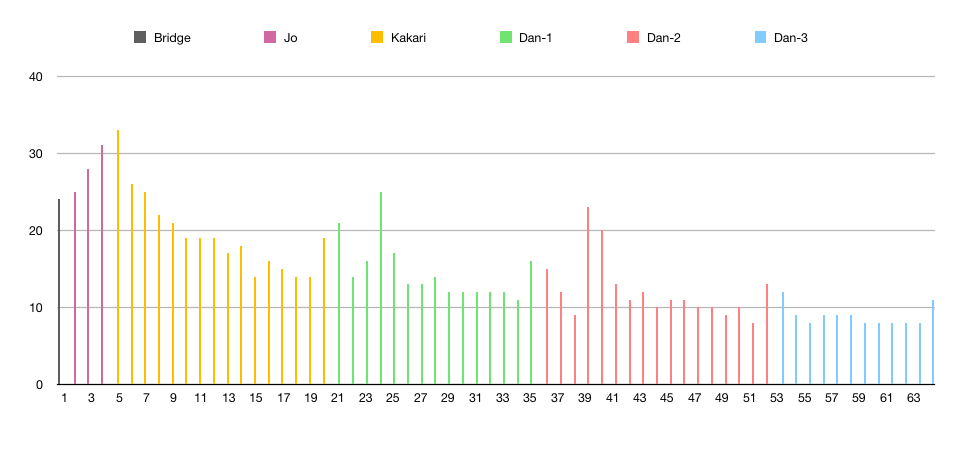Catalog of Shōdan: Dance
Jonomai
This refined and calm dance, which can be performed by an old man character, is typically presented by female characters, as is the case with Hashitomi. Like all instrumental dances, the Jonomai has three layers: the dance, the nohkan, and the percussion instruments. The nohkan provides a cyclical melodic background, and through its recurring patterns articulates the dance’s five sections: jo, kakari, and three dan. The complete dance, as presented in the full play recording, includes five sections. However, some Jonomai include only two or even one dan. The name jonomai derives from the introductory section jo, which can be translated as “an introduction.”
Jo
The three honji-long section stands apart from the rest of the dance, as well as from most instrumental dances, as a section that includes a non-congruent nohkan part and percussion in flexible rhythm.
Kakari
Kakari is the noun derived from the verb kakaru, which means “to initiate” or “to get into something.” In the context of the Jonomai, kakari could be understood as getting into the congruent-mode phase of the dance, which makes it the introduction's second step after jo.
In this section, the nohkan introduces the dance’s core sequence of patterns called Ji or 'ground.' The Ji will be used repeatedly in this and the remaining sections of the dance. It is composed of four eight-beat segments: Chū, Kan, Kannochū, and Ryo, where Kannochū is either a variation or repetition of Chū. Each segment begins on the second-and-a-half beat of its honji. The sequenced four patterns produce a melodic line whose shape is a four-honji long wave with the Chū pattern in medium range, Kan raising into higher range, then back to the medium range in the Kannochū, before reaching the lower range in the Ryo. The Ji pattern is played four times in this kakari.
Dan
The section's name comes from the nohkan's opening pattern called dan. The beginning of each dan can be recognized by an extended ’iya’ kakegoe by the ōtsuzumi player.
A dan includes two parts. Part I consists of a short sequence of new and recurring nohkan segments:
Dan I - Part I has five segments: Dan, Kannochū, Oroshi, Kannochū, and Ryo.
Dan II - Part I has an almost identical sequence of patterns except that the Oroshi is preceded by a Ryo. This results in the following sequence: Dan, Kannochū, Ryo, Oroshi, Kannochū, and Ryo.
In the first two dan, all patterns are eight-beats long except for the Oroshi, which lasts sixteen beats. Oroshi is also a unique moment of significant slowdown.
Dan III - Part I is slightly different, and is composed of the following: Dan, Chū, Ryo, where all segments are eight-beat long except for the Dan, which lasts sixteen.
All Dan - Part II sections are comprised of two Ji as heard in kakari, plus unique combinations of one or two additional segments.
The structure of the jonomai as performed by the Kongō school can be summarized as follows:
There is a special note on the oroshi pattern: it is not only the longest but also the slowest, since oroshi means “to slow down.” The Jonomai’s five sections are spread over sixty-four honji, as shown in this figure, where the Y-axis gives duration in seconds (the higher the peak the slower the tempo):

The figure shows that the five sections are merged into an overall accelerando that is relaxed in the first and second dan, where the highest peaks correspond to the two-honji long Oroshi.
The beginning of Hashitomi's Jonomai is preceded by a one-honji bridge from the preceding shōdan, the Kuse. The jiutai, accompanied by the two percussion instruments, introduces the first line of the poem Genji wrote in response to Lady Yūgao’s. The jiutai extends the poem’s last vowel over the next honji, overlapping with the beginning of the Jonomai.
The instrumental version of the Jonomai included in this Catalog of Shōdan is abridged. It starts with the bridge from the Kuse, followed by the Jo's three honji, which leads to Kakari with four presentations of the Ji pattern.